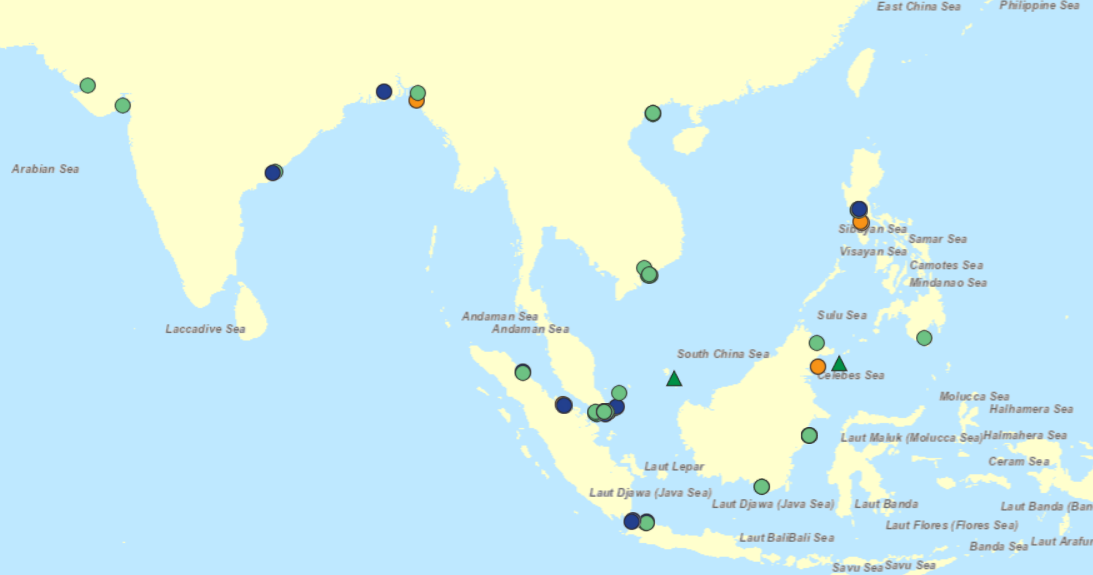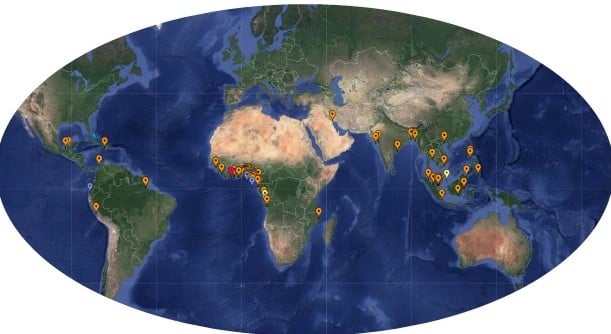BLOG
5 Questions about the current situation of piracy
- General Shipping
2021.04.23
Many people may think that "piracy" is an activity from the past, but piracy exists today. This blog will introduce the current situation regarding present day piracy taking place in parts of Asia and Africa, and the countermeasures used against them.
Where is piracy occurring?
What comes to mind when you hear the word "pirates"? Maybe you think of the Vikings of Northern Europe or the pirates you learned about in your history textbooks? In the past, there was a period when pirates were very active in the Caribbean Sea. Movies such as the "Pirates of the Caribbean" were modelled on the pirates of that time.
However, pirates soon disappeared as coastal countries went about securing their interests in maritime affairs such as military, trade, and exploration, managing to maintain a degree of security on the seas. In Japan also, action was taken to remove the scourge of piracy, Toyotomi Hideyoshi, the second great unifier of Japan, proclaimed the “Piracy Prohibition Edicts,” on 8 July 1588. In these edicts he strictly prohibited piracy over a very large area, probably all the territory coming under his influence. As a result, pirates became a somewhat nostalgic figure in folk tales.
However, pirates remain a threat in some areas of the World today.
Areas currently suffering a surge in piracy include the Malacca-Singapore Straits, the Sulu-Celebes Seas (southeast of the Philippines), the Gulf of Aden in Africa, off the coast of Somalia, and the Gulf of Guinea in Africa.

Details of incidents in the Sulu-Celebes Seas can be viewed.
Source: Regional Cooperation Agreement on Combating Piracy and Armed Robbery against Ships in Asia (ReCAAP) Interactive Incident Map

Source: IMB Annual Report 2020
For Japan, the Malacca-Singapore Straits is a transit point for sea lanes (marine traffic routes), particularly from the Middle East from where 90% of its crude oil imports are received. The Gulf of Aden and off the coast of Somalia are key points for maritime traffic connecting Japan and Europe. Ensuring the safety of merchant ships passing through these waters is one of the top priorities in maritime transportation.
What is piracy today?
Piracy is defined in Article 101 of the United Nations Convention on the Law of the Sea as follows:
Piracy consists of any of the following acts:
(a) any illegal acts of violence or detention, or any act of depredation, committed for private ends by the crew or the passengers of a private ship or a private aircraft, and directed:
(i) on the high seas, against another ship or aircraft, or against persons or property on board such ship or aircraft;
(ii) against a ship, aircraft, persons or property in a place outside the jurisdiction of any State;
(b) any act of voluntary participation in the operation of a ship or of an aircraft with knowledge of facts making it a pirate ship or aircraft;
(c) any act of inciting or of intentionally facilitating an act described in subparagraph (a) or (b).
The methods and tools used for the acts of piracy have changed and evolved over time. Pirates frequently access vessels via a long ladder placed on the freeboard (the side of a ship). Targeted vessels include tankers, merchant ships, and fishing boats, and pirates chase targeted vessels in high-speed and small boats, communicating with each other by transceiver. In the Sulu-Celebes Seas, off the coast of Somalia, and in the Gulf of Guinea, the pirates are usually heavily armed with weapons such as machine guns and rocket launchers. Crews can be held hostage and a ransom demanded for the release of the vessel and crew. Pirates in the Malacca-Singapore Straits, besides demanding money and goods from the crew, also try to rob the ship of machinery and equipment. Sometimes ships are snatched along with the cargo. In 2020, there were incidents of kidnapping of seafarers in the Sulu-Celebes Seas and the eastern part of Sabah, Malaysia.

Piracy off Somalia is characterized by the use of heavy weapons.
(Left) A pirate off the coast of Somalia holding an automatic rifle (front)
and a rocket launcher (rear).
(Right) A small ship used in a raid.
Source: Japan Shipowners' Association
What is current piracy situation in the Malacca-Singapore Straits?
Piracy had been going on for some time, but it was the hijacking, or ship-jacking, of the Alondra Rainbow in October 1999 that brought global attention. The Alondra was on its way to Japan from Sumatra, Indonesia, carrying alminium ingots when it was attacked by pirates in the Malacca-Singapore Straits and robbed of its cargo and ship. The 17 crew members, including a Japanese captain and chief engineer, were put on a life raft and eventually rescued by Thai fishermen after drifting for 10 days. The Alondra’s hull was repainted and the vessel renamed. However, it was captured by the Indian Coast Guard along with the group of Indonesian pirates who were operating the vessel. This incident triggered the establishment of an international cooperative framework for anti-piracy measures, and the international criminal organization responsible for the incident was exposed. There have been no more major ship-jackings since then.
On the other hand, incidents where small boats and fishing boats are attacked have not disappeared. In March 2005, the "Idaten (498 tons)", a tugboat*1 owned by a Japanese shipping company, was attacked by pirates in the Malacca-Singapore Straits and its Japanese captain, chief engineer, and a Filipino third officer were kidnapped. Such armed robberies around the Malacca-Singapore Straits have targeted small vessels such as barges*2 and robbed them of their cargo (scrap, etc.).
*1 Tugboat
A vessel used to tow or push a vessel in a narrow port to assist in arrival or departure from the port, to indicate the vessel course, or to embark or disembark a pilot.
*2. Barge Ships
A barge is a flat-bottomed vessel that carries heavy cargo through inland waterways such as canals and rivers, or in ports.
What is the piracy situation off the coast of Somalia?
Somali pirates typically attack and hijack merchant ships using heavy weaponry such as automatic rifles and rocket launchers, hold the crew hostage and then demand a ransom for the release of the crew and vessel. Of the 111 incidents of Somali piracy that occurred in 2008, 42 vessels were ship-jacked, and 815 people were taken hostage, posing a major threat to the international community. In March 2011, a tanker owned by Mitsui O.S.K. Lines (MOL) also became a victim of piracy. Four pirates boarded the Guanabara, a 57,462 gross ton crude oil tanker operated by MOL and registered in the Bahamas and attempted to hijack the vessel by firing automatic rifles. The vessel was rescued by a U.S. Navy vessel after receiving a distress call from the Guanabara, and the four Somali pirates were taken into custody. All crew members who were foreign nationals and had evacuated to the wheelhouse were released safe and well.
What is the background behind these frequent incidents of piracy off the coast of Somalia? Since the fall of the Somalian government in 1991, Somalia has been in a state of chaos with no government in effective control of the entire country, and internal conflicts have intensified. In addition, the government could no longer afford to crack down on pirates. A combination of these factors resulted in a breeding ground for piracy.
What is the international community's approach to the piracy problem?
Off the northern coast of Somalia lies the Gulf of Aden, an important maritime traffic route connecting Asia and Europe via the Suez Canal. Ship passing through the Suez Canal must pass through this area, not only on their way from the Middle East to Japan, but also on their way from Europe to Asia. The rapid increase in the number of piracy incidents such as ship-jacking and the taking of hostages, has raised awareness of the problem of piracy in the international community and prompted both governments and private sectors to consider effective counter-piracy measures.
In 2008, the United Nations adopted a Security Council resolution on combating piracy in order to ensure the safety of humanitarian aid shipments and trade routes. This resolution moved many countries to send naval vessels to guard their ships, and the number of cases of the armed suppression of pirates increased.
In January 2011, South Korean navy special forces rescued a hijacked South Korean-registered chemical tanker off the coast of Somalia after a firefight that resulted in the rescue of all 21 crew members.
The Japanese government also began efforts to combat piracy off the coast of Somalia. Since 2009, Japan has dispatched destroyers of the Maritime Self-Defence Force to escort ships in the Gulf of Aden and participated in international cooperation against piracy by flying P-3C patrol aircrafts to monitor the area from the sky. These activities are still ongoing and contribute greatly to the safe navigation of international shipping and the Japanese merchant fleet.

A destroyer escorting a passenger ship
Source: Cabinet Secretariat, 2020 Anti-Piracy Report, March 2021
Inter-Ministerial Task Force on Anti-Piracy off the Coast of Somalia and in the Gulf of Aden
How many Incidence of piracy are occurred?
According to the International Chamber of Commerce (ICC) International Maritime Bureau (IMB) Annual report 2020, there were 195 incidents of piracy and armed robbery worldwide in 2020. Of these 195 incidents, 88 were reported in African waters and 66 in Asian waters. The Gulf of Guinea in West Africa has recently been attracting attention as a frequent area of piracy and armed robbery. 88 incidents occurred in the Gulf of Guinea in 2020, with 35 occurring off the coast of Nigeria, accounting for a large percentage of the total figure. The next largest number of cases was around 26 cases in Indonesia, Asia.

Piracy incidents off the coast of Somalia,
in the Gulf of Aden and surrounding areas (IMB Annual Report)
Source: Cabinet Secretariat, 2020 Anti-Piracy Report, March 2021
Inter-Ministerial Task Force on Anti-Piracy off the Coast of Somalia and in the Gulf of Aden
Translated by MOL
As for the number of piracy incidents in the Malacca-Singapore Straits (much of the straits are in Malaysian waters) the number of incidents has fallen to less than 25 per year largely due to better security and patrols by the Singapore Coast Guard and the Malaysian Navy. The number of cases around Indonesia was 49 in 2016, down by half from the previous year. There are more than 17,000 islands in Indonesia, with Java lying at the centre of the country. It was therefore thought that it would take some time to resolve the piracy problem due to the perception that Northern Sumatra and the outlying islands were relatively remote. However, the anti-piracy measures taken have proved to be effective.

Changes in the Number of Piracy Incidents in Indonesian Territorial Waters
Source: Statista
However, according to the ReCAAP report, there were 97 piracy incidents in Asia in 2020, and there is no sign of these abating.
Of these, 69 were in the Malacca-Singapore Straits and around Indonesia and the Philippines. In recent years, the Asian region acts of piracy have typically been thefts in armed robberies, with little harm being done to the crew. Nevertheless, the threat of piracy continues and Japanese shipping officials, who are the largest users of Asian waters, must remain alert to piracy in Asian waters and continue to take self-defense measures.

Japanese patrol vessels patrolling Indonesian waters
Source: Jakaruta Shimbun
The Northern Sea Route is one region where there is no chance of encountering pirates. In 2018, MOL delivered the world's first icebreaking LNG carrier and began operating the Northern Sea Route (summer only) to transport liquefied natural gas (LNG) from Russia to China. You can read more about the Northern Sea Route in our series of blogs.
MOL aims to become a top runner in Arctic Ocean shipping in order to achieve both a stable transportation of resources and a reduction of CO2 emissions.
For an overview of the Northern Sea Route, please see this blog:

Writer:Akina
Joined MOL in 2014 after working for a credit card company. After being in charge of car carriers administration, operating bulk carriers, now I’ve been involved in the operation of this website, in the marketing division. I'm also in charge of website news letter. Easy to subscribe, please click below!
Recommended Articles
2022.07.05
- General Shipping
2021.04.13
- Energy
2023.12.19
- General Shipping
2021.08.07
- Eco Friendly
2025.03.18
- General Shipping
Latest Articles
2025.12.09
- Eco Friendly
- General Shipping
2025.12.03
- General Shipping
2025.11.20
- Energy
- General Shipping









